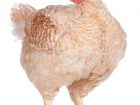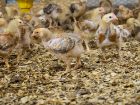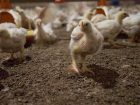
Slow-growth broiler chickens
By Treena Hein
Features Research WelfareWith Whole Foods wanting all the chicken it sells to be slow-growth, a look at the issues and evidence.
 Whole Foods wants meat from slow-growth chickens, claiming that they’re healthier, happier and taste better. But some critics argue that activists, not evidence, are behind the push. Pictured is a slow-growth broiler breed from Hubbard.
Whole Foods wants meat from slow-growth chickens, claiming that they’re healthier, happier and taste better. But some critics argue that activists, not evidence, are behind the push. Pictured is a slow-growth broiler breed from Hubbard. The topic of slow-growth broilers is a complex one, with a battle to sway public opinion seemingly at the forefront. As background, about a century ago it took around four months for a typical commercial chicken to get to three pounds. Today’s broilers reach about twice that size in about half the time due to changes in production factors such as genetics and nutrition.
Some animal welfare activists say the rapid rate of weight gain of today’s commercial broilers overwhelms their young bones, causing things like splayed legs, joint problems, inability to walk, heart problems, sudden death and more. These health and welfare concerns, along with what it also identifies as better-tasting chicken, has prompted upscale grocery store chain Whole Foods Market, which was recently purchased by Amazon, to act. Last year, the company announced a desire for all its suppliers to switch over the next eight years to only raising slower-growing broiler strains.
Whole Foods’ Canadian meat buyer Jessica Robson says that while her company doesn’t have a specific timeline on the rollout of slow-growth chickens here, “many of our Canadian producers have already expressed their enthusiasm and interest.” She does not specify how much consumer interest played a role in the mandated switch, and the company says it is too early to tell whether it foresees sourcing problems in Canada or the U.S. for slow-growth broilers.
It seems on the surface that the Whole Foods switch to slower-growth broilers is falling in line with an initiative announced in March 2016 by a separate U.S.-based animal welfare organization called Global Animal Partnership (GAP). GAP seemingly wishes to try and replace all fast-growing chicken breeds in the U.S. with slower-growing breeds by 2024, within its Five-Step Animal Welfare Rating Program. Whole Foods committed its support to the rating program at the time.
However, a closer look reveals the two entities to be very much interconnected. GAP was founded in 2008 with assistance from Whole Foods. Indeed, before that, the company had successfully applied its own animal welfare rating program to its U.K. suppliers. It then decided a separate organization would be more effective on an international level. Whole Foods confirms that it used to donate $200,000 a year to GAP, but now provides support for labelling fees and two full-time staff.
SLOW-GROWTH RESEARCH
Some broiler strains are recommended over others for slow-growth production. In June, GAP announced funding to “determine and evaluate the parameters necessary for assessing the animal welfare needs of different genetic strains.” This two-year research project will start this fall at the University of Guelph (U of G) in Ontario, led by Dr. Tina Widowski, chair in animal welfare, director of the university’s internationally known Campbell Centre for the Study of Animal Welfare and research chair of poultry welfare for the Egg Farmers of Canada, as well as senior research scientist Dr. Stephanie Torrey, both in the university’s department of animal biosciences.
This study builds on research going back many years into the effects of rapid broiler weight gain, such as study published in 1999 by U of G’s Dr. Richard Julian. At the time, he found that selection of chickens with high muscle-to-bone ratio and the practices of feeding them high-calorie nutritionally complete rations “causes significant mortality from cardiovascular disease” from sudden death to pulmonary hypertension syndrome, along with severe lameness, bone defects and deformity. He also found similarities in turkeys.
According to Torrey, the major chicken genetics companies have been actively including leg strength in their selection programs for a number of years, and have successfully reduced incidences of lameness, heart issues and death in fast-growing broiler strains. However, she says most of the data is proprietary and that there are few long-term scientific studies looking at lameness and mortality in standard commercial strains. She notes that nutrition, management and hatching can significantly affect lameness and mortality, and that her study with Widowski will control these factors.
One solution that’s been talked about for reducing the negative effects of rapid growth in broilers is reduction of feed intake without affecting final body weight. On that topic, Torrey urges a look at the big picture. “Broiler chickens have been genetically selected for generations for huge appetites, and as such, it’s difficult to reduce their feed intake without introducing other welfare concerns such as chronic hunger,” she notes. “Certainly, lower density diets – lower protein levels or higher fibre levels – can slow growth to some degree. However, genetics play a much larger role in growth rates than nutrition.”
Torrey adds that broiler growth can be slowed somewhat through nutrition, “and when done in the first couple weeks of life, this can help strengthen bones and organs to support fast growth in the last couple weeks of life.” In addition, she says other management strategies, such as reducing the photoperiod, can also have a positive effect on health and welfare.
Regarding other solutions, Torrey points out that giving birds the opportunity to exercise, through provision of platforms, perches and obstacles, may help strengthen bones and reduce some health issues related to rapid growth. Some hatchery parameters might also play important roles. “We also think that factors related to the breeding stock,” she says, “in particular, different feed restriction strategies, could lead to epigenetic changes [behavioural changes that do not involve DNA changes] in broilers’ feeding patterns, which could be harnessed to improve broiler welfare.”
NATIONAL ASSOCIATIONS WEIGH IN
For its part, the National Chicken Council (NCC) asserts that all available data on mortality, disease, digestive health, leg health and more, indicates that the collective American broiler flock is as healthy as ever. It’s currently updating its Broiler Welfare Guidelines with assistance from an advisory panel, guidelines which will be certified by an independent third party. Partly, the update is being based on a 2016 study commissioned by the NCC. An early 2017 NCC press release states that this study shows large-scale production of slower-growing chickens will cause “a sharp increase in chicken prices and the use of environmental resources – including water, air, fuel and land.” NCC also calls for more research on the health impact of growth rates.
Chicken Farmers of Canada (CFC) is currently looking to convert the study results into Canadian parameters, but Lisa Bishop-Spencer, CFC manager of communications, says the environmental impact would be similar and possibly greater due to the Canadian climate. “All animals require a certain amount of energy daily to maintain themselves, and slower-growing birds will have greater total energy requirements because it takes more days for them to reach market weight,” she notes. “That means more to feed them, more land and water to grow the feed, more fuel, more barns and emissions for transportation and more manure produced.”
CFC has received very little indication that there is any significant Canadian consumer demand for slow-growth broilers, and indeed, the organization does not see the topic as consumer-driven.
“The desire to replace slower-growing birds as a full-on replacement to conventional chicken appears to be coming from some animal rights activists, people who aren’t meat eaters and whose primary mission is to eliminate meat consumption altogether by making it more difficult, more frustrating and more expensive for chicken farmers to do their jobs and more expensive for consumers,” Bishop-Spencer explains. “It’s activists masquerading as consumers who are demanding this change, and they’re trying to link slower-growing birds and animal welfare when it’s uncertain if having slow-growing birds will have any impact on welfare. It’s yet another attempt to raise doubts and lower trust, with the eventual aim of eliminating meat from everyone’s diet. It’s about creating an atmosphere of guilt, and it’s a shameful tactic that targets a hardworking value chain that brings so much to the Canadian economy and way of life.”
She concludes that we all buy food for our own reasons – cost, value, nutrition, convenience, among many others – and that many Canadian consumers have a wide range of choice in what they wish to buy, from organic, free-range and slower-growing to vegetarian-grain-fed, specialty breed or conventional chicken. “Canadian chicken farmers have proven that they’re ready to adapt to a changing Canadian palate and will work hard to continue to meet consumer demands,” she notes, “but we’re not willing to do it when it’s being driven by activists who ultimately want to force our farmers out of business.”
A look at GAP’s 5 Steps program
Whole Foods’ embrace of slower-growth chickens closely relates to its adoption of the Global Animal Partnership’s (GAP) 5-Step Animal Welfare Rating Program. The five steps specify a series of marketing claims followers of the program can make based on their adherence to a list of standards, with the fifth step supposedly being the highest achievement.
The steps include:
- No cages, no crates, no crowding
- Enriched environment
- Enhanced outdoor access
- Pasture centered
- Animal centered; no physical alterations
For chickens, the program includes caps on growth rates – the slower the growth, the higher up the stepladder a company moves. For example, to qualify for steps one to three, the maximum average growth rate of the chicken a company sells must not exceed 68 grams (0.150 pounds) per day. To reach the highest level, that rate is capped at five grams (0.077 pounds) per day.
There have been a few sets of allegations relating to the 5-Step program. In 2015, PETA (People for the Ethical Treatment of Animals) filed a lawsuit against Whole Foods, stating that the program and its associated labelling were deceiving customers.
PETA stated at the time that the program’s audit process was “a sham because it occurs infrequently and violations of the standards do not cause loss of certification.” The case was dismissed in early 2016 because the judge felt PETA had not proven the alleged misrepresentations by Whole Foods were defrauding the public.
This spring, Whole Foods, GAP and the Humane Society of the United States (HSUS) were targeted in a complaint submitted to the IRS (Internal Revenue Service) by a U.S. non-profit animal-activist-watchdog group called the Center for Consumer Freedom. In short, the complaint alleges that HSUS is using tax-exempt charitable donations to promote GAP and Whole Foods’ business interests. (Another piece of the puzzle is the fact that Whole Foods CEO John Mackey sits on the HSUS board and HSUS CEO Wayne Pacelle serves on the board of GAP.)
The complaint alleges that HSUS and several other animal rights organizations are pressuring and even threatening to attack brands unless the food companies who own them commit to buying GAP-certified products, which Whole Foods agreed to do very early on. On the GAP website, 63 brands of various types of meat are currently listed as GAP-certified, with some of these brands being owned by the same companies.
Print this page



